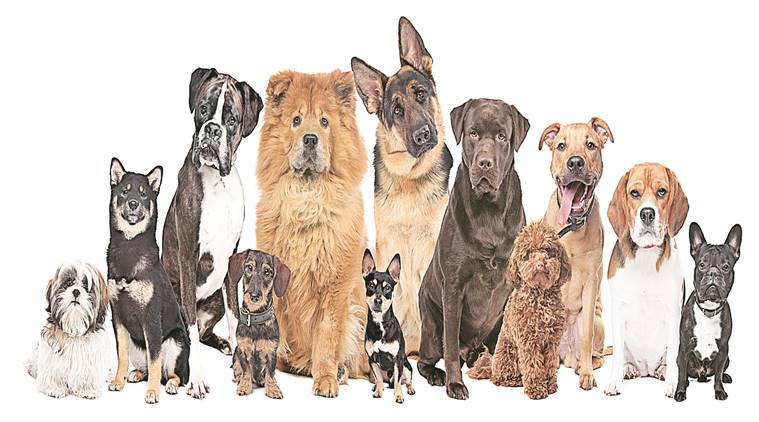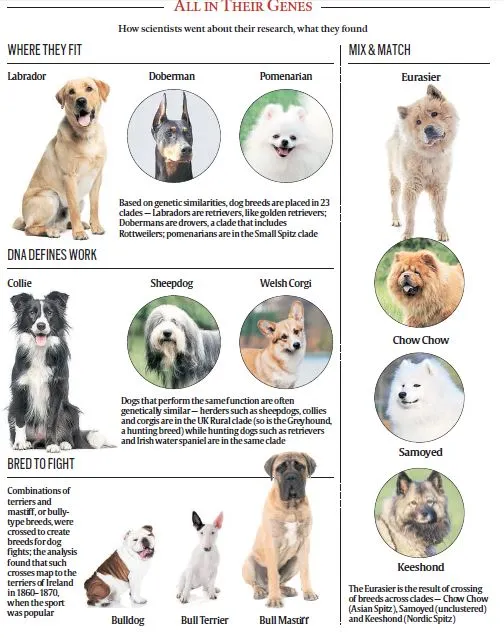The family tree of dogs
In the largest data set yet on DNA of dogs, clues about how various modern breeds came about, when and where human beings crossed different breeds, and why
 Information about the origins of these breeds, however, has been largely isolated, with studies so far having covered a limited number of breeds.
Information about the origins of these breeds, however, has been largely isolated, with studies so far having covered a limited number of breeds.
The modern dog comes in various forms and sizes, an estimated 400 breeds, a large number of them having come about when humans crossed one breed with another at various stages of history. Information about the origins of these breeds, however, has been largely isolated, with studies so far having covered a limited number of breeds.
Now, a team of geneticists has set about mapping a family tree on the largest scale that has been attempted yet. Heidi Parker, Elaine Ostrander and their colleagues at the National Human Genome Research Institute in Maryland, US, studied the genetic makeup of 1,346 dogs of 161 breeds from across the world, looked for clues about which parent breeds were crossed with which — besides when, where and why — and are now keen to fill out the rest of the map.
“This chart has 161 breeds but there are over 400 breeds recognised worldwide,” Ostrander told The Indian Express by email. “We’d like to include all of those breeds to help us better understand the development of dog breeds, particularly from the East, including most definitely India.”
The study, reported in the journal Cell Reports, accounts for geographical location, migration of human populations with their pets, and interbreeding between immigrant and indigenous dogs to produce hybrids, which later became independent breeds.
The interbreeding was often deliberate, based on the function for which people wanted dogs as they went from hunting-gathering to farming and finally urban lifestyles. Along the way, some 200 years ago, came what the authors call the “Victorian era breed explosion”, when humans started to refine breed types into very specific breeds.

“For example,” the study notes, “when dog fighting was a popular form of entertainment, many combinations of terriers and mastiff or bully-type breeds were crossed to create dogs that would excel in that sport.” The genetic study found bull-and-terrier crosses mapping to the terriers of Ireland and dating to 1860–1870, coinciding with the time when the sport was popular.
Based on the extent of genetic similarities, the researchers clubbed the breeds into 23 groupings called “clades”. First, dogs of the same breed grouped together. “Then the breeds were grouped by how similar their genomes were to other breeds, and again, and again,” said Dayna Dreger, one of the authors. “All of this is purely at the genome level, so we are blind to any of the identities or breeds of the individual dogs prior to analysis.”
The study found that the clades so defined often brought together breeds that performed the same tasks, suggesting they had been developed for those very purposes. Hunting dogs such as Labrador retrievers, golden retrievers and Irish water spaniels were in the same clade, for example, as were various breeds of herding dogs.
And yet, there is diversity among herders too. UK Rural herding dogs such as the Old English and Shetland sheepdogs were found highly divergent from Mediterranean herders such as the Anatolian shepherd and the Azawakh. With the genetic comparison showing no recent mixing between these two clades, the study suggests the similar traits of these breeds arose independently.
Then again, cross-breeding can take place across clades. In a few extreme cases that threw up a striking match of genetic identifiers between breeds of different clades, the study suggests that the interbreeding was recent. It cites the example of the Eurasier, a descendant of the Chow Chow, the Samoyed and the Keeshond, all of different clades.
Conversely, some clades show little or no evidence of breeding outside. “The Scent Hound clade is one example,” said Dreger. “There is evidence of crossing between breeds within that clade, but very little evidence to suggest that any Scent Hounds were incorporated into other breeds.”
Domestication of dogs is believed to have begun thousands of years ago in Central Asia. Some dogs of Asian breeds migrated to the Americas, and it was widely believed that the arrival of European breeds replaced the early American dogs. The new study has now found that DNA of indigenous breeds persists in some modern American dogs, including the Chinese crested dog — which it says originated in Central America.
In compiling the data set, the researchers took help from all over the world in collecting DNA samples. If anyone sends an email describing what they have, Ostrander said, “We will mail them sample kits to collect the DNA and mailers to send it back.”







